Scottish Prison Population Statistics: Legal Status, 2019-20
Experimental prison population statistics covering the period 2009-10 to 2019-20, expanding on the previous publication with information about legal statuses, sentences and offences.
1 Average Daily Populations by Legal Status
1.1 Explaining legal status
An individual can be held in custody for a number of reasons set out in the Criminal Procedure (Scotland) Act 1995:
- They may have been convicted of an offence and their sentence may comprise (wholly or in part) a custodial disposal (i.e held as Sentenced)
- They may have been convicted of an offence and been remanded in to custody by the court to await final sentencing (i.e. held as Convicted awaiting sentence)
- They may have been charged with an offence and have been remanded in to custody to await further criminal proceedings (i.e. held as Untried)
On any given day, the prison population comprises three key groups: the sentenced population, the untried population, and the convicted awaiting sentence population. The untried and convicted awaiting sentence populations are often referred to as the remand population (the sum of the two groups combined).
If an individual has committed multiple offences at different points in time it is possible for them to be involved in multiple criminal proceedings and therefore have multiple legal statuses. For example, an individual may have been given a custodial disposal for a particular offence but may be awaiting trial for a further offence whilst serving this sentence. This individual is therefore held in the sentenced population but is subject to an untried warrant at the same time.
For the purposes of this publication individuals only appear with one legal status (sentenced – convicted awaiting sentence – untried). If an individual is serving a custodial sentence but has an outstanding untried or awaiting sentence warrant, they are classed here as in the sentenced population. Similarly, if an individual is convicted awaiting sentence for one (or multiple) offence/s but also has an outstanding untried warrant they are classed here as convicted awaiting sentence. Transitions between legal statuses are explored in Section 4 of this report.
1.2 Overall average daily populations
As reported in the previous publication for 2019-20 between 2010-11 and 2011-12, there was a continuation of a general rising trend in the prison population which was then followed by several years of steady reduction. However, between 2017-18 and 2019-20, the average daily prison population rose steeply from around 7,500 in 2017-18 to nearly 8,200 in 2019-20, an increase of almost 10% over a 2 year period. By 2019-20, the overall average prison population exceeded the population levels at the previous peak in 2011-12.
Breaking this down by legal status (Figure 1), the overall trend is broadly reflected in both the sentenced and untried populations. The sentenced population peaks in 2012-13 at 6,606, declining to 6,155 by 2017-18. The untried population peaks in 2011-12 at 1,146, declining to 947 by 2017-18. Both populations then rise steeply to 2019-20 (reaching 6,621 and 1,177 respectively, and representing increases of 7.6% and 24.3% from 2017-18). By 2019-20, the average daily population for both groups exceeded the previous peak levels in 2011-12 and 2012-13. Looking at the average daily convicted awaiting sentence population (shown as CAS in the chart), this group is broadly stable over the time period observed remaining between 300 and 360 throughout.
As a proportion of the overall population, the size of the remand population (comprising both the untried and convicted awaiting sentence populations) shows signs of modest growth. In 2019-20 it stood at 18.7% of the population – the highest level since 2011-12 (when it was 18.6%).
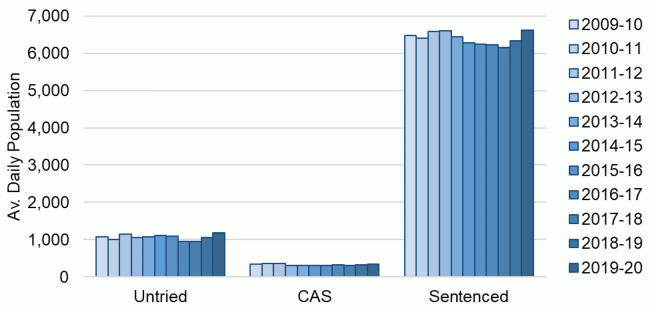
1.3 Women in custody
The prison population is largely comprised of men aged 21 and over. Women and young people (section 1.4) are held separately in custodial establishments and distinct approaches have been developed to manage these particular groups within the prison system[4].
Following a rapid rise to its peak in 2011-12, the average daily population of women in custody fell until 2016-17. By 2019-20, the average daily population had risen to around 400. Unlike the overall average daily population trend however, the women’s average daily population in 2019-20 (402) remains below the 2011-12 peak (468).
Breaking these trends down by legal status (Figure 2), the women’s sentenced population shows a substantial fall between 2011-12 and 2016-17 followed by an increase in 2018-19 (from 284 in 2016-17 to 303 in 2018-19, an increase of almost 7%).
The average daily untried population remained largely stable from 2016-17, albeit increasing by around 29% to 2019-20 (from 52 to 67). The average daily convicted awaiting sentence population is also relatively stable, albeit with an observable decrease between 2011-12 to 2015-16.
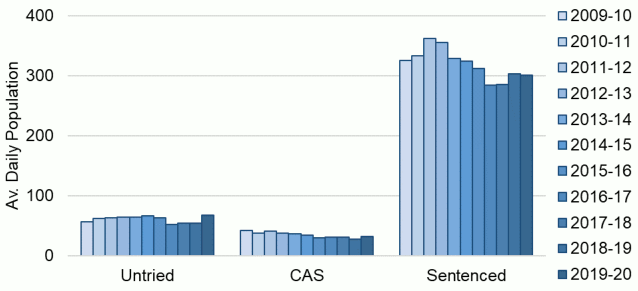
As a proportion of the average population, remand has consistently accounted for a higher proportion of the women’s average daily prison population than men’s. Between 2009-10 and 2019-20, between 21% and 25% of the women’s average daily population are recorded as remand, compared to 17%-18% of the men’s average daily population. Figure 3 provides a comparison for 2019-20.
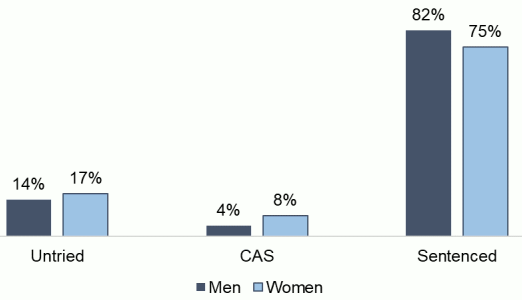
1.4 Young People in Custody
The previous publication highlighted the substantial drop in the number of young people in the average daily prison population over time. The average number of young people in custody (those under 21 years) dropped from around 864 in 2010-11 to around 325 in 2019-20[5].
Breaking this down further, this overall downward trend is observed across all legal status types (Figure 4). However, for the untried and sentenced legal statuses, the downward trend for 18-20 year olds appears to be levelling off from 2017-18 onwards. Nevertheless, the average daily untried and sentenced populations for both groups are substantially lower in 2019-20 than in 2009-10.
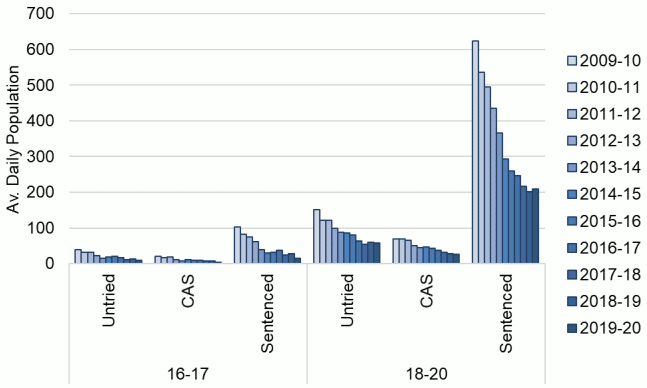
A higher proportion of the young people’s average daily populations are held on remand when compared against the overall average daily population, and the proportions vary more year to year. For 18-20 year olds, the proportion of the average daily population held on remand fluctuates between 25% and 32%, and the proportion for 16 and 17 year olds fluctuates between around a third of the average daily population to around half. The absolute number of 16 and 17 year olds is very low however (see Figure 4 above).
1.5 Ethnic groups in custody
The previous publication examined ethnicity of individuals in custody using broad Census groups.[6] The average daily population of individuals from ethnic groups other than white is small in absolute terms[7]. Breaking these small groups down further by legal status means analysis of trends and the quantification of change over time have to be undertaken and interpreted with caution.
As they comprise the overwhelming majority of the prison population, the average daily population of individuals identifying as white closely follows the trends identified in the overall average daily population above. Similar trends can be observed in the average daily populations of those identifying as ‘African, Caribbean or Black’ and ‘Asian, Asian Scottish or Asian British’ in Figure 5. While both groups show a decline in their average untried populations over the longer term, both saw an increase from 2018-19 to 2019-20 (from 15 to 20 and from 18 to 31 respectively). Similarly, both show overall declines in the average daily sentenced population (from 91 and 135 in 2009-10 to 72 and 107 in 2019-20), and both show fluctuations in the average daily convicted awaiting sentence populations (albeit for both groups the average daily convicted awaiting sentence population is fewer than 10 individuals from 2010-11 onwards).
For those identifying as ‘Mixed or multiple ethnic groups’ or‘Other ethnic group’, the pattern is different. Here, both groups show increases in their average daily populations over time, across each legal status type while numbers remain very small overall. For those identifying as ‘Mixed or multiple ethnic group’, the average daily untried and convicted awaiting sentence populations contain fewer than 10 individuals across the time period observed, and the average daily sentenced population rises from 8 in 2009-10 to 23 in 2019-20. For those identifying as ‘Other ethnic group’, the average daily convicted awaiting sentence population remains below 5 individuals over the time period observed. The average daily untried and sentenced populations rise from 5 and 12 in 2009-10 to 17 and 40 in 2019-20.
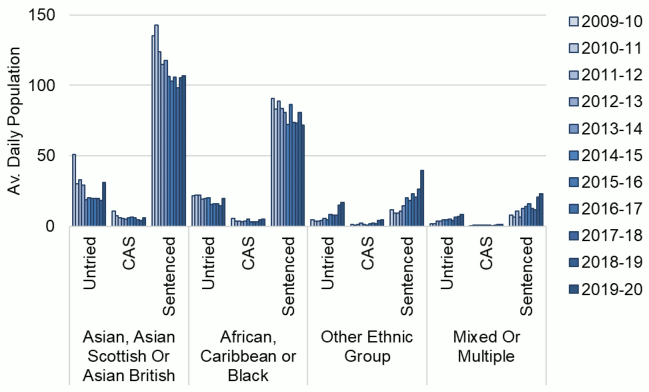
The share of the population on remand (untried and convicted awaiting sentence combined) among minority ethnic groups taken together varied between 21.2% and 28.4% between 2009-10 and 2019-20 – somewhat higher than the prison population as a whole. In the census the link between ethnic minority identity and relative youth was clear[8]. The relatively high levels of remand among minority ethnic groups is likely associated with the relative youth of this group, shown in section 1.4. Given the small numbers of individuals these breakdowns cannot be further explored here.
In 2019-20, 28% of people in an ethnic group other than ‘White’ were on remand. The aggregation of ethnic groupings in this report are likely to mask variations within each group. Disaggregation of prisoner ethnicity data continues to be pursued for more in-depth analyses.
Contact
Email: jamie.robertson@gov.scot
There is a problem
Thanks for your feedback